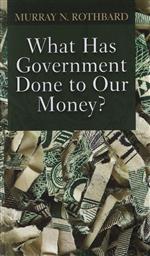What Has Government Done to Our Money? and The Case for a 100 Percent Gold Dollar (Book/ Paperback)
by Murray N. RothbardProduct Overview
The book made huge theoretical advances. He was the first to prove that the government, and only the government, can destroy money on a mass scale, and he showed exactly how they go about this dirty deed. But just as importantly, it is beautifully written. He tells a thrilling story because he loves the subject so much.
The passion that Murray feels for the topic comes through in the prose and transfers to the reader. Readers become excited about the subject, and tell others. Students tell professors. Some, like the great Ron Paul of Texas, have even run for political office after having read it.
Rothbard shows precisely how banks create money out of thin air and how the central bank, backed by government power, allows them to get away with it. He shows how exchange rates and interest rates would work in a true free market. When it comes to describing the end of the gold standard, he is not content to describe the big trends. He names names and ferrets out all the interest groups involved.
Since Rothbard's death, scholars have worked to assess his legacy, and many of them agree that this little book is one of his most important. Though it has sometimes been inauspiciously packaged and is surprisingly short, its argument took huge strides toward explaining that it is impossible to understand public affairs in our time without understanding money and its destruction.
This volume's contents include:
Preface by Jorg Guido Hulsmann
I. Introduction by Murray Rothbard
II. Money in a Free Society
1. The Value of Exchange
2. Barter
3. Indirect Exchange
4. Benefits of Money
5. The Monetary Unit
6. The Shape of Money
7. Private Coinage
8. The Proper Supply of Money
9. The Problem of Hoarding
10. Stabilize the Price Level?
11. Coexisting Moneys
12. Money-Warehouses
13. Summary
III. Government Meddling With Money
1. The Revenue of Government
2. The Economic Effects of Inflation
3. Compulsory Monopoly of the Mint
4. Debasement
5. Gresham's Law and Coinage
6. Summary: Government and Coinage
7. Permitting Banks to Refuse Payment
8. Central Banking: Removing the Checks on Inflation
9. Central Banking: Directing the Inflation
10. Going Off the Gold Standard
11. Fiat Money and the Gold Problem
12. Fiat Money and Gresham's Law
13. Government and Money
IV. The Monetary Breakdown of the West
1. Phase I: The Classical Gold Standard, 1815-1914
2. Phase II: World War I and After
3. Phase III: The Gold Exchange Standard (Britain and the United States) 1926-1931
4. Phase IV: Fluctuating Fiat Currencies, 1931-1945...
5. Phase V: Bretton Woods and the New Gold Exchange Standard (the United States) 1945 1968
6. Phase VI: The Unraveling of Bretton Woods, 1968-1971
7. Phase VII: The End of Bretton Woods: Fluctuating Fiat Currencies, August-December, 1971
8. Phase VIII: The Smithsonian Agreement, December 1971-February 1973
9. Phase IX: Fluctuating Fiat Currencies, March 1973-?
This book is also part of our An Introduction and History of Money Set.
About the Author(s)
Murray N. Rothbard
Murray N. Rothbard, the author of 25 books and thousands of articles, was a historian, philosopher, and dean of the Austrian School of economics. The S.J. Hall Distinguished Professor of Economics at the University of Nevada, Las Vegas, he was also Academic Vice President of the Ludwig von Mises Institute in Auburn, AL.
List Price: $14.00
Our Price: $8.59
You Save:
$5.41(39%)
+ Free Shipping w/ $45 min. purchase
Category: Business & Economics
Format: Book (Paperback) (122)
Publisher: Ludwig von Mises Institute
Date Published: Dec 03, 2010
Language: English
ISBN: 9781610161428
SKU: LT-1408
Dimensions: 4.25 x 7.00 x 0.25 (in)
Weight: 4.20 oz










